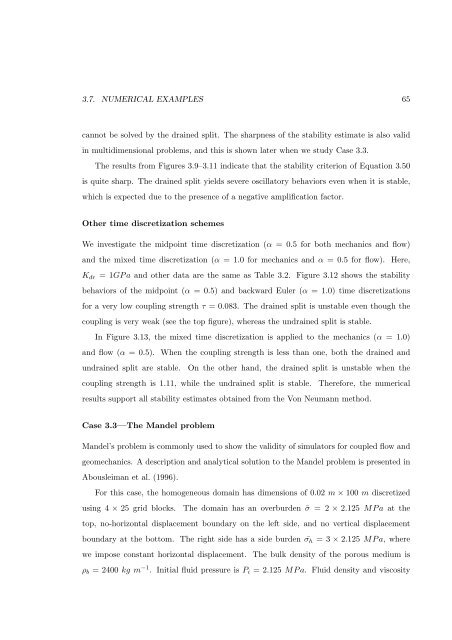Sequential Methods for Coupled Geomechanics and Multiphase Flow
Sequential Methods for Coupled Geomechanics and Multiphase Flow
Sequential Methods for Coupled Geomechanics and Multiphase Flow
Create successful ePaper yourself
Turn your PDF publications into a flip-book with our unique Google optimized e-Paper software.
3.7. NUMERICAL EXAMPLES 65<br />
cannot be solved by the drained split. The sharpness of the stability estimate is also valid<br />
in multidimensional problems, <strong>and</strong> this is shown later when we study Case 3.3.<br />
The results from Figures 3.9–3.11 indicate that the stability criterion of Equation 3.50<br />
is quite sharp. The drained split yields severe oscillatory behaviors even when it is stable,<br />
which is expected due to the presence of a negative amplification factor.<br />
Other time discretization schemes<br />
We investigate the midpoint time discretization (α = 0.5 <strong>for</strong> both mechanics <strong>and</strong> flow)<br />
<strong>and</strong> the mixed time discretization (α = 1.0 <strong>for</strong> mechanics <strong>and</strong> α = 0.5 <strong>for</strong> flow). Here,<br />
Kdr = 1GPa <strong>and</strong> other data are the same as Table 3.2. Figure 3.12 shows the stability<br />
behaviors of the midpoint (α = 0.5) <strong>and</strong> backward Euler (α = 1.0) time discretizations<br />
<strong>for</strong> a very low coupling strength τ = 0.083. The drained split is unstable even though the<br />
coupling is very weak (see the top figure), whereas the undrained split is stable.<br />
In Figure 3.13, the mixed time discretization is applied to the mechanics (α = 1.0)<br />
<strong>and</strong> flow (α = 0.5). When the coupling strength is less than one, both the drained <strong>and</strong><br />
undrained split are stable. On the other h<strong>and</strong>, the drained split is unstable when the<br />
coupling strength is 1.11, while the undrained split is stable. There<strong>for</strong>e, the numerical<br />
results support all stability estimates obtained from the Von Neumann method.<br />
Case 3.3—The M<strong>and</strong>el problem<br />
M<strong>and</strong>el’s problem is commonly used to show the validity of simulators <strong>for</strong> coupled flow <strong>and</strong><br />
geomechanics. A description <strong>and</strong> analytical solution to the M<strong>and</strong>el problem is presented in<br />
Abousleiman et al. (1996).<br />
For this case, the homogeneous domain has dimensions of 0.02 m × 100 m discretized<br />
using 4 × 25 grid blocks. The domain has an overburden ¯σ = 2 × 2.125 MPa at the<br />
top, no-horizontal displacement boundary on the left side, <strong>and</strong> no vertical displacement<br />
boundary at the bottom. The right side has a side burden σh ¯ = 3 × 2.125 MPa, where<br />
we impose constant horizontal displacement. The bulk density of the porous medium is<br />
ρb = 2400 kg m −1 . Initial fluid pressure is Pi = 2.125 MPa. Fluid density <strong>and</strong> viscosity
















